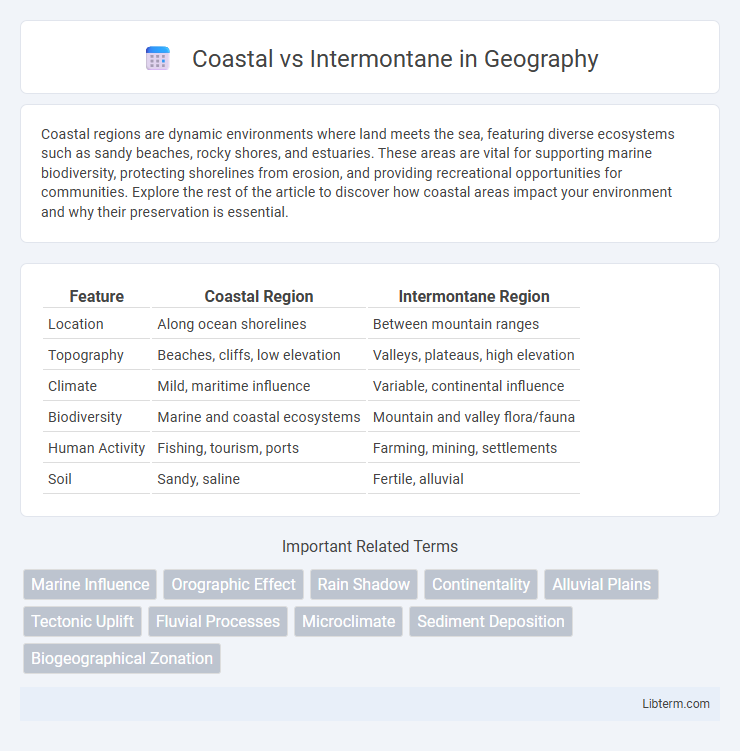Coastal regions are dynamic environments where land meets the sea, featuring diverse ecosystems such as sandy beaches, rocky shores, and estuaries. These areas are vital for supporting marine biodiversity, protecting shorelines from erosion, and providing recreational opportunities for communities. Explore the rest of the article to discover how coastal areas impact your environment and why their preservation is essential.
Table of Comparison
| Feature | Coastal Region | Intermontane Region |
|---|---|---|
| Location | Along ocean shorelines | Between mountain ranges |
| Topography | Beaches, cliffs, low elevation | Valleys, plateaus, high elevation |
| Climate | Mild, maritime influence | Variable, continental influence |
| Biodiversity | Marine and coastal ecosystems | Mountain and valley flora/fauna |
| Human Activity | Fishing, tourism, ports | Farming, mining, settlements |
| Soil | Sandy, saline | Fertile, alluvial |
Defining Coastal and Intermontane Regions
Coastal regions are defined by their proximity to oceanic shorelines, characterized by maritime climates, sandy beaches, and estuaries influenced by tidal patterns. Intermontane regions lie between mountain ranges, featuring valleys or plateaus with distinct continental climates marked by temperature extremes and diverse ecosystems adapted to elevation and isolation. Understanding these definitions clarifies geographic distribution, climate variation, and ecological differentiation across landscapes.
Geographic Distribution and Characteristics
Coastal regions are characterized by low-lying land adjacent to oceans, featuring moderate climates with high humidity and abundant marine influence, commonly found along continental shores such as the Pacific Coast of North America. Intermontane areas lie between mountain ranges, often exhibiting varied elevation and climatic conditions, typically marked by dry valleys, basins, and plateaus such as the Intermontane Plateaus in the western United States. These geographic distributions influence biodiversity and human settlement patterns, with coastal zones supporting marine ecosystems and dense populations, while intermontane regions often have more rugged terrain and sparse habitation.
Climate Patterns and Weather Differences
Coastal regions experience mild, humid climates with moderate temperatures year-round due to oceanic influence, resulting in frequent fog, precipitation, and stable weather patterns. Intermontane zones typically have a continental climate characterized by greater temperature extremes, lower humidity, and less precipitation, often leading to dry summers and cold winters. These contrasting climate patterns significantly influence local ecosystems, agricultural practices, and water resource management in each area.
Biodiversity and Ecosystem Variations
Coastal regions exhibit high biodiversity due to their diverse habitats, including estuaries, salt marshes, and mangroves that support a wide range of marine and terrestrial species. Intermontane areas, situated between mountain ranges, feature unique ecosystems with distinct flora and fauna adapted to isolated valleys and variable microclimates, leading to high endemism. The contrast in humidity, elevation, and soil types drives significant variation in ecosystem structures and species composition between Coastal and Intermontane zones.
Human Settlement and Population Density
Coastal regions exhibit higher human settlement and population density due to access to waterways, trade routes, and fertile land supporting agriculture and urban development. Intermontane areas, characterized by rugged terrain and limited arable land, show sparse population distribution and smaller, more isolated communities. Infrastructure challenges and harsher climates in intermontane zones further inhibit large-scale human habitation compared to coastal zones.
Economic Activities and Resource Utilization
Coastal regions thrive on fishing, shipping, tourism, and port-related industries due to their access to oceans and natural harbors, supporting trade and aquaculture. Intermontane zones rely heavily on mining, forestry, agriculture, and hydroelectric power generation, leveraging rich mineral deposits, dense forests, fertile valleys, and river systems. Resource utilization in coastal areas emphasizes sustainable marine management, while intermontane regions focus on mineral extraction and renewable energy development.
Transportation and Accessibility Challenges
Coastal regions benefit from extensive port facilities and well-developed highway networks, facilitating efficient transportation of goods and passengers compared to Intermontane areas. Intermontane zones face significant accessibility challenges due to rugged terrain, limited road infrastructure, and weather-related disruptions, hindering reliable connectivity. These geographic constraints impact economic development by increasing transportation costs and limiting trade flow within and beyond Intermontane regions.
Cultural Influences and Historical Development
Coastal regions exhibit diverse cultural influences shaped by maritime trade, colonization, and migration, fostering cosmopolitan societies with blended traditions and languages. Intermontane areas often preserve indigenous cultures and historical practices due to geographic isolation, resulting in unique art, rituals, and languages less impacted by external forces. The historical development of coastal zones is marked by economic hubs and colonial ports, while intermontane regions maintain continuity of ancestral customs alongside gradual adaptation to modernity.
Environmental Concerns and Conservation Efforts
Coastal regions face rising sea levels, increased storm surges, and habitat loss due to urbanization, necessitating robust conservation efforts like wetland restoration and marine protected areas. Intermontane zones contend with challenges such as deforestation, biodiversity loss, and water scarcity, prompting initiatives focused on sustainable forest management and watershed protection. Both environments require tailored strategies to address their unique ecological vulnerabilities and support long-term environmental resilience.
Future Trends and Regional Sustainability
Coastal regions face rising sea levels and increased storm intensity, driving innovations in resilient infrastructure and adaptive urban planning to ensure long-term sustainability. Intermontane areas prioritize water resource management and biodiversity conservation as climate change alters precipitation patterns, fostering sustainable agriculture and renewable energy projects. Emerging technologies and regional policies emphasize integrated ecosystem management to balance economic growth with environmental preservation in both coastal and intermontane zones.
Coastal Infographic

 libterm.com
libterm.com